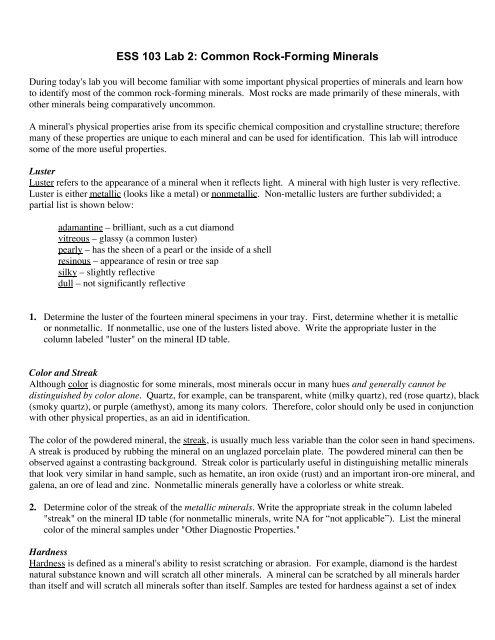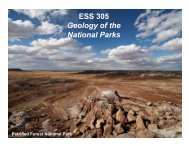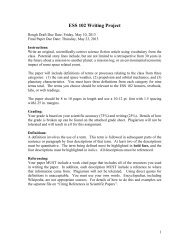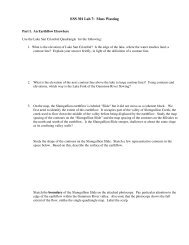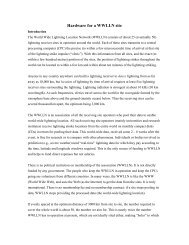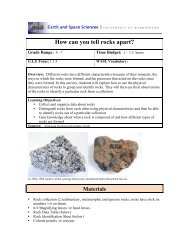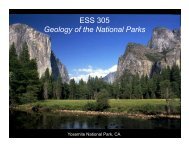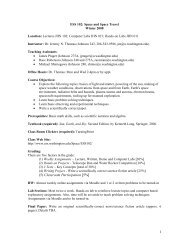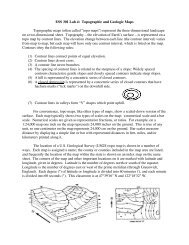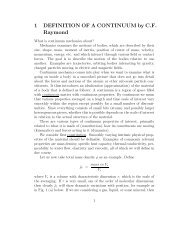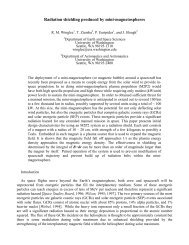Common Rock-Forming Minerals - Earth and Space Sciences
Common Rock-Forming Minerals - Earth and Space Sciences
Common Rock-Forming Minerals - Earth and Space Sciences
You also want an ePaper? Increase the reach of your titles
YUMPU automatically turns print PDFs into web optimized ePapers that Google loves.
ESS 103 Lab 2: <strong>Common</strong> <strong>Rock</strong>-<strong>Forming</strong> <strong>Minerals</strong><br />
During today's lab you will become familiar with some important physical properties of minerals <strong>and</strong> learn how<br />
to identify most of the common rock-forming minerals. Most rocks are made primarily of these minerals, with<br />
other minerals being comparatively uncommon.<br />
A mineral's physical properties arise from its specific chemical composition <strong>and</strong> crystalline structure; therefore<br />
many of these properties are unique to each mineral <strong>and</strong> can be used for identification. This lab will introduce<br />
some of the more useful properties.<br />
Luster<br />
Luster refers to the appearance of a mineral when it reflects light. A mineral with high luster is very reflective.<br />
Luster is either metallic (looks like a metal) or nonmetallic. Non-metallic lusters are further subdivided; a<br />
partial list is shown below:<br />
adamantine – brilliant, such as a cut diamond<br />
vitreous – glassy (a common luster)<br />
pearly – has the sheen of a pearl or the inside of a shell<br />
resinous – appearance of resin or tree sap<br />
silky – slightly reflective<br />
dull – not significantly reflective<br />
1. Determine the luster of the fourteen mineral specimens in your tray. First, determine whether it is metallic<br />
or nonmetallic. If nonmetallic, use one of the lusters listed above. Write the appropriate luster in the<br />
column labeled "luster" on the mineral ID table.<br />
Color <strong>and</strong> Streak<br />
Although color is diagnostic for some minerals, most minerals occur in many hues <strong>and</strong> generally cannot be<br />
distinguished by color alone. Quartz, for example, can be transparent, white (milky quartz), red (rose quartz), black<br />
(smoky quartz), or purple (amethyst), among its many colors. Therefore, color should only be used in conjunction<br />
with other physical properties, as an aid in identification.<br />
The color of the powdered mineral, the streak, is usually much less variable than the color seen in h<strong>and</strong> specimens.<br />
A streak is produced by rubbing the mineral on an unglazed porcelain plate. The powdered mineral can then be<br />
observed against a contrasting background. Streak color is particularly useful in distinguishing metallic minerals<br />
that look very similar in h<strong>and</strong> sample, such as hematite, an iron oxide (rust) <strong>and</strong> an important iron-ore mineral, <strong>and</strong><br />
galena, an ore of lead <strong>and</strong> zinc. Nonmetallic minerals generally have a colorless or white streak.<br />
2. Determine color of the streak of the metallic minerals. Write the appropriate streak in the column labeled<br />
"streak" on the mineral ID table (for nonmetallic minerals, write NA for “not applicable”). List the mineral<br />
color of the mineral samples under "Other Diagnostic Properties."<br />
Hardness<br />
Hardness is defined as a mineral's ability to resist scratching or abrasion. For example, diamond is the hardest<br />
natural substance known <strong>and</strong> will scratch all other minerals. A mineral can be scratched by all minerals harder<br />
than itself <strong>and</strong> will scratch all minerals softer than itself. Samples are tested for hardness against a set of index
minerals that are scaled from 1 (softest) to 10 (hardest), called Mohs Hardness Scale (below). Mineral hardness<br />
is determined by comparing the relative hardness of an unknown specimen with an index mineral or other<br />
material with known hardness. Glass is often used because: (1) it is easy to see a scratch on glass, <strong>and</strong> (2) the<br />
hardness of glass is about midway on Mohs Scale. A set of probes of known hardness is available, as well.<br />
3. The hardness of a mineral is often one of its most diagnostic properties. Determine whether your fourteen<br />
mineral samples are harder than, softer than, or similar to the hardness of glass. (<strong>Minerals</strong> that are similar to<br />
the hardness of glass will sometimes scratch glass.) Write “harder”, “softer”, or “similar” in the column<br />
labeled "hardness" on the mineral ID table.<br />
4. Use the hardness testing kit to bracket the hardness of the following minerals on Mohs Hardness Scale.<br />
Specimen #<br />
1<br />
Hardness<br />
6<br />
7
Cleavage <strong>and</strong> Fracture<br />
Cleavage is the tendency of a mineral to split, or cleave, along closely spaced parallel planes. The planes along<br />
which a mineral cleaves (when hit with a hammer, for example) are the planes along which the bonds between<br />
atoms in the mineral are the weakest. <strong>Minerals</strong> that break easily <strong>and</strong> cleanly along one or more planes are said to<br />
have good cleavage. If the break is less clean the cleavage is referred to as poor. The number of cleavage planes<br />
<strong>and</strong> the angles between cleavage planes are commonly used to distinguish minerals. The table below includes<br />
examples of cleavage in common minerals.<br />
# of Cleavage<br />
Planes<br />
Angle Between<br />
Planes<br />
Shape Sketch Number of<br />
Flat Surfaces<br />
0 NA Irregular masses 0<br />
No cleavage,<br />
only fracture<br />
1 NA Flat sheets 2<br />
2 90° Elongate form with<br />
rectangular crosssection,<br />
rough ends<br />
2 not at<br />
90°<br />
Elongate form with<br />
parallelogram crosssection,<br />
rough ends<br />
3 90° Cube 6<br />
4<br />
4<br />
3 not at<br />
90°<br />
4 not at<br />
90°<br />
6 not at<br />
90°<br />
Rhombohedron 6<br />
Octahedron 8<br />
Dodecahedron 12<br />
Mica minerals have only one cleavage plane, producing a series of sheets. Halite has cleavage in three<br />
directions, with all planes at right angles (90°). Note that even though a cube has six sides, opposite sides are<br />
parallel to each other <strong>and</strong> therefore represent the same cleavage plane. A cubic shape represents three<br />
cleavage planes, not six.<br />
Cleavage planes are flat <strong>and</strong> will reflect light at a uniform angle. Slowly turn a mineral under light <strong>and</strong> watch<br />
for these reflections. Hold transparent samples up to a light <strong>and</strong> look for cleavage planes running through the<br />
interior, too. Also note that some minerals have corners or "steps" along their edges, indicating at least two<br />
different planes of cleavage.<br />
<strong>Minerals</strong> that don't readily split along planes will instead break, or fracture, along uneven surfaces. Many<br />
minerals fracture smoothly along curved, shell-like surfaces, sometimes forming sharp edges (like broken<br />
glass). This is called conchoidal fracture. Other types of fracture include fibrous, rough, <strong>and</strong> earthy (like<br />
broken chalk).
Examples of how a mineral surface reflects light for minerals with (A) good cleavage, (B) poor cleavage, <strong>and</strong><br />
(C) fracture.<br />
Cleavage surfaces may be confused with crystal growth faces; in fact cleavage planes are sometimes parallel to<br />
growth faces. They can be distinguished as follows. (1) Growth faces are normally smooth, whereas cleavage<br />
planes, though also smooth, commonly are broken in a step-like fashion. (2) Some growth faces have fine<br />
grooves or ridges on their surfaces, whereas cleavage planes generally do not. (Plagioclase is an exception — it<br />
has striations on its cleavage planes.) (3) Finally, unless growth faces happen to coincide with cleavage planes,<br />
the mineral will not break parallel to growth faces.<br />
5. Determine whether the flat faces on the following minerals are crystal growth faces or are due to cleavage.<br />
Specimen #<br />
Cleavage/Crystal Face<br />
8<br />
9<br />
6. How many cleavage planes are there in the following minerals If there is more than one cleavage<br />
direction, what is the angle between cleavage planes (“NA”, “90°”, or “Not at 90°”)<br />
Specimen # # Planes Angle Between<br />
Cleavage Planes<br />
10<br />
11<br />
12<br />
13
7. Determine whether your fourteen mineral specimens have cleavage or fracture. (Remember, not all flat<br />
surfaces are cleavage planes; some are crystal faces. Use the characteristics described above to distinguish<br />
between the two types of flat surfaces.) If the mineral exhibits only fracture, write “fracture” in the column<br />
labeled "cleavage/fracture" on the mineral ID table. If the mineral exhibits cleavage, write the number of<br />
cleavage planes (1,2,3,4, or 6) <strong>and</strong> angle between planes (“NA”, “90°”, or “Not at 90°”) on the mineral ID<br />
table. If the mineral exhibits crystal faces, make a note of this in the “Other Diagnostic Properties” column<br />
of the table.<br />
Specific Gravity<br />
Specific gravity is a measure of relative density. It is determined by comparing the mass of a material to the<br />
mass of an equal volume of water. A mineral with a specific gravity of 3.0 would be three times heavier than an<br />
equal volume of water. Specific gravity is not expressed in units of any kind, as it is a ratio.<br />
specific gravity = mass of mineral<br />
mass of equal volume of water<br />
Specific gravity can be measured by using Archimedes' principle, one of the fundamental principles of physical<br />
science. Archimedes noted that a specimen weighs less when immersed in water than it does when weighed in<br />
air. He noted further that the loss of weight in water (weight in air minus weight in water) is exactly equal to<br />
the weight of the displaced volume of water. Therefore, the equation above can be rewritten as:<br />
specific gravity = weight of mineral in air<br />
weight in air minus weight in water<br />
8. Using the hydrometer (directions are included), determine the specific gravity of the following minerals:<br />
Specimen #<br />
5<br />
Weight of<br />
Mineral in Air<br />
(grams)<br />
Weight of<br />
Mineral in<br />
Water (grams)<br />
Weight in Air<br />
Minus Weight in<br />
Water (grams)<br />
Specific<br />
Gravity<br />
14<br />
Other Properties<br />
Magnetism - Some minerals, such as magnetite, are attracted to magnets.<br />
Taste - Some minerals have a characteristic taste. For example, halite tastes like salt.<br />
Acid reaction - Some minerals that contain carbonate (CO3) will react with diluted hydrochloric acid (HCl),<br />
forming carbon dioxide (CO2) gas bubbles. Calcite (CaCO3) will react with HCl.<br />
Feel - Some minerals, such as talc, feel soapy or greasy.<br />
Presence of striations - Some minerals, such as pyrite, have closely spaced fine grooves on their crystal faces.
Step 1<br />
Step 2<br />
Step 3<br />
Determine whether the mineral has a metallic (go to step 2) or nonmetallic (go to step 3) luster. If you are uncertain<br />
about a mineral's luster, then it is probably nonmetallic.<br />
If the mineral is metallic, determine the mineral's characteristics in the following order <strong>and</strong> use Table A-1 to identify<br />
the mineral:<br />
i. streak<br />
ii. hardness<br />
iii. other properties as needed<br />
If the mineral is nonmetallic, determine the mineral's characteristics in the following order <strong>and</strong> use Table A-2 (lightcolored<br />
minerals) or Table A-3 (dark-colored minerals) to identify the mineral:<br />
i. hardness<br />
ii. number of cleavage planes <strong>and</strong> angles between cleavage planes<br />
iii. other properties as needed<br />
Determine the characteristics of the specimens below, then use Tables A-1, A-2, <strong>and</strong> A-3 to identify them.<br />
Specimen<br />
Number<br />
1<br />
Luster<br />
Streak<br />
(metallic<br />
minerals)<br />
Hardness<br />
(relative<br />
to glass)<br />
Cleavage/<br />
Fracture<br />
Other<br />
Diagnostic<br />
Properties<br />
Mineral<br />
Name<br />
2<br />
3<br />
4<br />
5<br />
6<br />
7<br />
8<br />
9<br />
10<br />
11<br />
12<br />
13<br />
14
Distinguishing similar-looking minerals.<br />
9. Name <strong>and</strong> describe three different physical characteristics for distinguishing quartz from calcite.<br />
10. What single diagnostic property is most useful for distinguishing between amphibole <strong>and</strong> biotite
Instructions for Use of Mineralab Model 1 Mineral Hydrometer Kit<br />
Note:<br />
The Mineralab hydrometer will measure the specific gravity of a mineral sample to ±3%<br />
when used with reasonable care. The three most important points are:<br />
1) Allow the temperature of the water <strong>and</strong> the float to equilibrate before use.<br />
2) Remove all air bubbles from the float <strong>and</strong> sample during use.<br />
3) Choose samples of appropriate size-- approximately 1 cm on a side.<br />
Overview:<br />
This hydrometer measures the specific gravity of a mineral by comparing its weight in air<br />
to its weight in water. Its chief advantage over other such tools is that the principle<br />
behind the measurement should be readily perceivable by the students.<br />
In practice, four steps need to be performed. First, the buoyancy of the empty float must<br />
be determined by adding weights to the upper pan <strong>and</strong> measuring the amount by which<br />
the float sinks. Second, a mineral sample is placed in the upper pan <strong>and</strong> its weight is<br />
measured. Third, the same sample is placed in the submerged chamber <strong>and</strong> its new<br />
weight is measured. Fourth, the specific gravity is calculated from the relationship<br />
Setup:<br />
Sp.Gr.=<br />
W air<br />
W air<br />
"W water<br />
.<br />
Unpack the hydrometer ! <strong>and</strong> its weights. The Ohaus weight set should consist of a pair of<br />
tweezers, brass weights of 50, 20, 10 (two), 5, 2 (two), <strong>and</strong> 1 g, <strong>and</strong> sheet metal weights<br />
of 500, 200 (two), <strong>and</strong> 100 mg. The hydrometer consists of a tube with one fixed <strong>and</strong> one<br />
removable end cap, a float assembly with an adjustable lower counterweight, <strong>and</strong> an<br />
aluminum cylinder of known specific gravity (2.70).<br />
Fill the tube with water to the indicated level, approximately 6.4 cm from the top. Extend<br />
the lower counterweight on the float, taking care not to dislodge the internal red plastic<br />
cork. If necessary, the counterweight can be disassembled to permit removal of some of<br />
its brass weights, but it is simpler to choose mineral samples of similar weights so that<br />
this can be avoided. Place the float in the water, then swirl <strong>and</strong> shake it to dislodge any<br />
bubbles. Time permitting, weigh it down <strong>and</strong> let it sit underwater for several minutes so<br />
that the temperature may equilibrate.
Use:<br />
First Measurement:<br />
Add weights to the upper pan until the float sinks to a point at which the yellow<br />
calibrated tube breaks the surface. This should take approximately 10 g. Record the<br />
weight <strong>and</strong> the measurement from the tube at the water line. Regrettably, for direct<br />
conversion between depth <strong>and</strong> weight in grams, the tube should be marked in decimeters,<br />
but is in fact marked in centimeters. Therefore, multiply the tube's reading by 0.1 g/cm,<br />
then add this figure to the weight.<br />
Example: If 9.200 g have been placed in the pan <strong>and</strong> the tube reads 4.8 cm, then the total<br />
weight is 9.200 g + 0.48 g, or 9.68 g.<br />
Call this figure the calibration, or W cal .<br />
Second Measurement:<br />
Remove the weights, then place the mineral sample in the upper pan. Again, add weights<br />
to the upper pan until a reading can be made on the yellow tube. Multiply the tube's<br />
reading by 0.1 g/cm <strong>and</strong> add, as above.<br />
IMPORTANT: Subtract this total from the calibration, W cal , to get W air for the sample.<br />
Third Measurement:<br />
Remove the sample <strong>and</strong> weights from the upper pan. Place the sample in the submerged<br />
chamber through one of its two openings, taking care to avoid introducing air bubbles.<br />
Shake <strong>and</strong> tap the float to dislodge any bubbles that are present. Add weights to the<br />
upper pan, not to the submerged chamber, until a reading can be made on the yellow<br />
tube. Multiply the tube's reading by 0.1 g/cm <strong>and</strong> add, as above.<br />
IMPORTANT: Subtract this total from the calibration, W cal , to get W water for the sample.<br />
Calculation of Specific Gravity:<br />
Use the formula<br />
Sp.Gr.=<br />
W air<br />
W air<br />
"W water<br />
.<br />
!
Table A-1<br />
Metallic Mineral Identification Chart<br />
Luster Streak Hardness Cleavage Color Specific Other Properties Name<br />
Gravity<br />
6.0-6.5 No brass yellow 5.0 cubic crystals (with striations) common PYRITE<br />
6.0 No<br />
dark gray to<br />
black<br />
5.2 strongly magnetic MAGNETITE<br />
Dark Gray to<br />
Black<br />
3.5-4.0 No golden yellow 4.2 may tarnish to bronze or purple; massive CHALCOPYRITE<br />
Metallic<br />
2.5 Yes silvery gray 7.5 perfect cubic cleavage (3 planes at 90 o ) GALENA<br />
1.0 Yes-d gray to black 2.5 marks paper <strong>and</strong> fingers; greasy feel GRAPHITE<br />
Red to Red-<br />
Brown<br />
5.0-6.5 No<br />
silver to gray to<br />
red<br />
5.0 may be tiny glittering flakes HEMATITE<br />
Yellow-<br />
Brown<br />
3.5-4.0 Yes-d<br />
yellow-brown to<br />
dark brown<br />
4.0<br />
submetallic to resinous luster; 6 cleavage<br />
planes<br />
SPHALERITE<br />
Copper 2.5-3.0 No<br />
copper to dark<br />
brown<br />
8.9 malleable NATIVE COPPER<br />
Note: Yes-d means cleavage is present but may be difficult to see
Luster &<br />
Color<br />
Relative<br />
Hardness<br />
Table A-2. Light Colored Non-metallic Mineral Identification Chart<br />
Hardness Cleavage<br />
Color<br />
Specific<br />
Gravity<br />
Other Properties<br />
Name<br />
Harder than<br />
Glass<br />
7.0 Yes-d pistachio green 3.3-3.6 surface coatings, or massive EPIDOTE<br />
7.0 No variable 2.7<br />
vitreous luster; conchoidal fracture; massive<br />
but also occurs as 6-sided crystals<br />
QUARTZ<br />
6.0 Yes<br />
pinkish-orange<br />
(variable)<br />
2.5 vitreous luster; b<strong>and</strong>ing; 2 cleavages at 90 o ORTHOCLASE<br />
(Potassium Feldspar)<br />
Similar to<br />
Glass<br />
6.0 Yes white to gray 2.6-2.8<br />
vitreous luster; 2 cleavages at 90 o ; striations<br />
common on cleavage faces<br />
PLAGIOCLASE<br />
(Na & Ca Feldspar)<br />
5.0-7.0 Yes-d bluish-gray 3.5 vitreous luster; blade shaped crystals KYANITE<br />
Non-Metallic<br />
Light Colored<br />
4.0 Yes<br />
clear, purple,<br />
yellow (variable)<br />
3.2<br />
vitreous luster; 4 perfect cleavages forming<br />
octahedrons<br />
FLUORITE<br />
3.0 Yes<br />
white to clear<br />
(variable)<br />
2.7<br />
reacts with HCl; rhombic cleavage; 3 perfect<br />
cleavages not at 90 o<br />
CALCITE<br />
2.5 Yes<br />
clear to milky<br />
white<br />
2.2 3 perfect cleavages at 90 o (cubes); salty taste HALITE<br />
2.0-2.5 Yes-d white to tan 2.6<br />
dull luster, powdery; earthy odor; white<br />
streak<br />
KAOLINITE<br />
Softer than<br />
Glass<br />
2.0-2.5 Yes<br />
clear to light<br />
yellow<br />
2.5-3.0<br />
vitreous luster; perfect cleavage in 1<br />
dir.;forms flexible, transparent, thin sheets<br />
MUSCOVITE<br />
2.0 Yes<br />
clear, white, yellow<br />
(variable)<br />
2.3<br />
vitreous to pearly luster; brittle flakes;<br />
perfect cleavage in 1 direction<br />
GYPSUM<br />
1.5-2.5 No yellow 2.0 yellow streak; distinctive sulfurous odor SULFUR<br />
1.0 Yes-d<br />
apple green to<br />
silvery white<br />
2.7 pearly luster; greasy feel TALC<br />
Note: Yes-d means cleavage is present but may be difficult to see.
Luster &<br />
Color<br />
Relative<br />
Hardness<br />
Table A-3. Dark Colored Non-metallic Mineral Identification Chart<br />
Hardness Cleavage<br />
Color<br />
Specific<br />
Gravity<br />
Other Properties<br />
Name<br />
9.0 No brown (variable) 4.0 six-sided prismatic crystals CORUNDUM<br />
Harder<br />
than Glass<br />
7.0 Yes-d brown 3.8<br />
vitreous to dull luster; prismatic to crossshaped<br />
crystals<br />
STAUROLITE<br />
7.0 No red or brown 3.5-4.3 twelve-sided crystals common; vitreous luster GARNET<br />
7.0 No variable 2.7<br />
vitreous luster; conchoidal fracture; massive<br />
but also occurs as 6-sided crystals<br />
QUARTZ<br />
6.5-7.0 No olive green 3.3-4.4 vitreous luster; granular OLIVINE<br />
Non-Metallic<br />
Dark Colored<br />
6.0 Yes gray to white 2.6-2.8<br />
vitreous luster; 2 cleavages at 90 o ; striations<br />
common on cleavage faces<br />
PLAGIOCLASE<br />
5.0-6.0 Yes-d dark green to black 3.3 vitreous to dull luster; 2 poor cleavages at 90 o PYROXENE<br />
Similar to<br />
Glass<br />
5.0-6.0 Yes dark green to black 3.3<br />
vitreous luster; splintery appearance; 2 perfect<br />
cleavages at 120 o <strong>and</strong> 60 o<br />
AMPHIBOLE<br />
5.0-6.0 No<br />
5.0 Yes-d<br />
reddish-brown to<br />
black<br />
green, brown, blue,<br />
black<br />
5.0 red-brown streak; dull luster; massive HEMATITE<br />
3.2 vitreous luster; six-sided crystals common APATITE<br />
3.5-4.0 Yes-d grass green 4.0<br />
occurs as surface coatings, masses, or tiny<br />
crystals; green streak<br />
MALACHITE<br />
Softer<br />
than Glass<br />
2.5-3.0 Yes brown to black 2.8-3.0<br />
vitreous luster; perfect cleavage in 1 direction;<br />
forms flexible thin sheets<br />
BIOTITE<br />
flexible crystal flakes; crystal aggregates<br />
2.0-2.5 Yes-d dark or light green 2.6-2.9<br />
common<br />
Note: Yes-d means cleavage is present but may be difficult to see.<br />
CHLORITE


